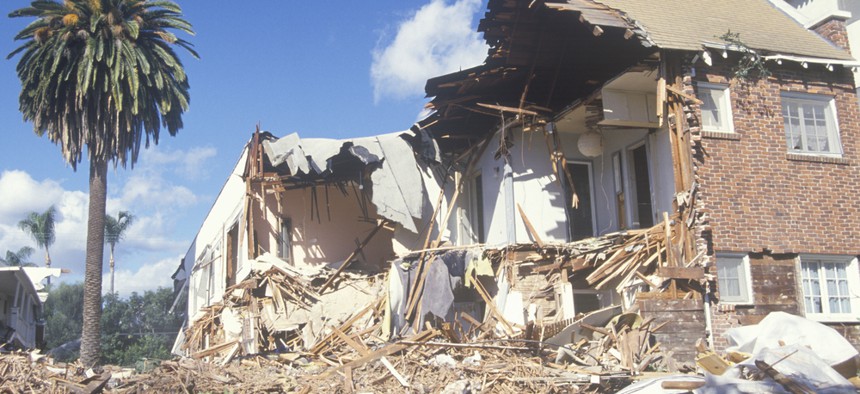California Gets Much-Needed Funds to Deploy Expanded Earthquake Early-Warning System

This Santa Monica apartment building sustained major damage during the 1994 Northridge earthquake in Southern California. American Spirit / Shutterstock.com

Connecting state and local government leaders
When fully deployed, Los Angeles could get as much as a one-minute heads up that destructive waves are headed toward the city from the San Andreas Fault.
LOS ANGELES — After several years of negotiations and pilot programs, California received $5 million of what lawmakers call a “down payment” on an earthquake early-warning system that proponents say gives cities valuable moments to make decisive decisions to hunker down before destructive seismic waves hit.
Such early-warning systems, already in place in Mexico and Japan, can’t predict when an earthquake will strike. But once a earthquake is detected, the early-warning system can send an alert faster than the seismic waves can travel through the ground.
That warning can give residents valuable seconds to seek shelter in a sturdy spot, hospital surgeons enough time to cease delicate operations and businesses and local agencies enough time to shut down or secure potentially vulnerable systems and infrastructure.
In the case nation’s second-largest city, such an early-warning system could give as much as a 1-minute warning before seismic waves from the next catastrophic quake originating on the southern portion of the San Andreas Fault reach the densely populated urban area more than 100 miles away.
According to the Los Angeles Times:
Officials plan to hook up the alerts to a public announcement system at a select number of schools to warn students and teachers to drop and cover. Others would be routed to fire stations, enabling garage doors to be opened before the power goes out or structural distortions jam the doors.
The funding for the early-warning system was included in the budget approved by the U.S. Senate over the weekend, allowing the expanded network to deploy in early 2015.
"We must get it done before the next major earthquake strikes," U.S. Sen. Dianne Feinstein said in a statement.
The U.S. Geological Survey oversaw the ShakeAlert system pilot program, which had stations at a number of regional universities, including the California Institute of Technology in Pasadena, the University of California at Berkeley and the University of Washington in Seattle.
The USGS wants to expand the system to cover all of California plus Oregon and Washington state, which will bear the brunt of the next Cascadia megathrust earthquake and tsunami.
A comprehensive West Coast early-warning system would run about $80 million over five years, or $16 million annually, according to The Associated Press.
So far, the pilot program has been limited to a few government agencies and private firms. Once expanded, it will reach schools, fire stations and other emergency response agencies.
In early tests, the early-warning system gave local agencies in the San Francisco area as much as a 10-second alert before the seismic waves from August’s 6.0 magnitude earthquake in Napa County reached the area. If that quake had hit during the daytime, the Bay Area Rapid Transit system, which has been part of the pilot project, would have had enough time to stop or slow it trains before seismic waves hit.
Although BART received a 10-second advanced warning during August’s quake, “the agency's computers took too long to process the information and the quake had ended by the time BART officials received the warning,” The Associated Press reported in October, noting that the delay has been eliminated.
(Top image by American Spirit / Shutterstock.com)




